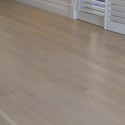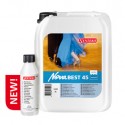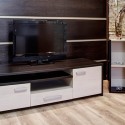If you cannot find an answer to your question here, please contact us.
The Swedish Finish
Synteko Pty. Ltd. provides floor-finishing products intended for use by professional floor contractors only. Our safety and health recommendations are intended to be general guidelines. Individuals with medical conditions or who are typically more sensitive to odours should consult their physicians and extend the time allowed prior to returning to the residence. A good rule of thumb is if you can still smell the odour upon returning, give yourself more time. Material Safety Data sheets are available on the Classic Product Listing.
Preparations Before Coating Application
Preparing for the finish application includes removing the following from any area that could be exposed to vapours: plants, animals, aquariums and food in open containers or in containers that could possibly absorb vapours (i.e. bread, cereal, grains, etc.).
Post-Coating Procedures
Following application of any type of floor coating, the key to a healthy living environment is two-fold. The temperature must be sufficient to promote curing of the finish and aggressive ventilation is needed to assure that the emitted vapours are expelled from the house.
The homeowner should not be in the area during application or drying. After the final coat of Synteko Classic has been applied and has dried sufficient to be dry to the touch, the contractor should initiate ventilation well before the homeowner reoccupies the space. Prior to coating, windows should be unlatched and doors unlocked. Then, when coating is dry to the touch, the windows and doors can be opened externally, eliminating the need to enter the house. Setting up box fans in one or several windows after fumes have dissipated for a few minutes is also quite effective and also does not require entering the house. For optimal coating appearance reasons, it is best to wait 24 hours after final coating before walking on the floors. However, with great care it is usually possible to enter sooner in order to turn on the airconditioning (if available) and exhaust fans to accelerate air exchanges for indoor air quality purposes.
The flooring contractor will know when the floor has dried sufficiently to not be damaged by cautiously crossing the floor. A proper respirator and filter should be worn, however, if the house must be entered during this curing period. Because of the need to take care not to damage the finish and because fumes are still present during this curing period, the contractor may want to perform this task.
The temperature should be maintained in the 18-20oC range during the drying period and when possible air-conditioning or fans should be run to accelerate air exchange.
These steps will optimise the air-exchange rate and eliminate odours rapidly. To fully evacuate all odours and promote curing of any “still” areas prone to little air movement, a fan should be set up to stir the air in that specific space (providing the finish has set sufficiently to not be marred by the fan base). Even when no apparent vapours remain, some ventilation, including one or more fans should be maintained in a central area of the house for at least one week as the coatings cure.
Synteko’s Swedish finishes, like hundreds of other commercial and consumer products, have formaldehyde-based resins. In fact, items such as mascara, nail polish, toothpaste, packaging, draperies, cabinets, trim boards, paint, insulation, furniture and plastics all contain formaldehyde. It is the formaldehyde-based resins that put the “permanent” in permanent press clothing and “strength” in wet-strength paper towels. In the Synteko Classic Swedish finish products, this resin assists in giving the finish its toughness and long-wearing characteristics. The amount of formaldehyde in Synteko Classic finishes is actually very small, comprising much less than one percent.
Once the product is cured (two to four weeks after application of final coat using the above guidelines for ventilation, temperature and under standard atmospheric conditions) the amount of residual formaldehyde emissions is virtually undetectable. What many assume is the odour of formaldehyde is actually that of the alcohol-based solvents. The human nose is able to detect vapour concentration of as low as one or two parts per million. For this reason, your nose is the best guide for indicating if additional ventilation is needed.
Reference materials on the subject of formaldehyde may be obtained from The Formaldehyde Institute, Inc., 1330 Connecticut Avenue, NW, Washington, DC, 20036.




